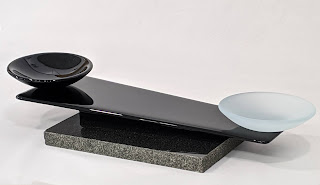 |
| A finished magless |
One of the on-line forums I participate in (
www.warmglass.com) has had a "magless" exchange for the past 10 years. A magless is a small magnet that...uh...doesn't include the actual magnet. The rules for the magless exchange are simple: the piece must be made of glass, it can use any technique, and it should be a minimum size of 1"x1" but no larger than 2"x2". When finished, you package your creations and send them to a central coordinator, who then mails one of each magless to every participant. (The omission of the magnet helps to keep the weight/shipping costs down.)
When thinking about what to create for the exchange, I had three goals in mind. I wanted to try a new technique, I wanted an opportunity to use an Inland Swaptop hobby saw I recently purchased, and I wanted to create something that was representative of Utah. I decided to create my maglesses using a technique that I've been calling a "frit sandwich", incorporating the colors of the Utah desert landscape. My idea was to create a slab and cut it into appropriately-sized pieces for the maglesses. The frit sandwich (or sand painting with frit) is by no means a new technique -- you can find instructions by various people on-line -- but it is a technique that allowed me to accomplish my three goals.
 |
| Binder clips hold the glass securely and act as a stand |
I decided to create two slabs so that I could test the technique and firing schedule with the first slab and adjust as necessary. I also knew a smaller slab would be easier to cut. I started with a 12" square piece of clear Spectrum System 96 glass and cut it in half. I then cut four narrow strips of clear (approx. 1/4"). Three narrow clear strips were glued along three edges of one of the 6x12" pieces with Elmers glue and then topped with the other 6x12" piece. It was all held in place along the three glued edges with binder clips and allowed to dry. The binder clips came in handy -- not only did they keep the glass sandwich securely together, but they also provided a nice way to stand the glass on edge when I was ready to fill it with frit.
 |
| Colorful frit & card stock "funnel" |
I drew lines approximately 1.25" apart horizontally on the glass sandwich with a marker to indicate the height of each cab. In keeping with the desert landscape theme, I choose Uroboros System 96 fine frits in Bronze, Cherry Red, Orange, Yellow, and Sapphire. (In hindsight, the Sapphire was more subtle than I had in mind -- I was hoping for a "bluer blue".)
 |
| A piece of floral wire is used to manipulate the frit |
I spooned frit onto a piece of card stock folded in half to act as a funnel for pouring the layers of frit into the glass. After I poured a layer of each of the colors, I used a piece of floral wire to manipulate the frit.I did this layer by layer until the sandwich was filled. I then capped it off with the remaining piece of narrow clear glued in place and allowed to dry.
 |
| Ready to cap and fuse |
I used a fairly standard full fuse firing schedule for the slab (in degrees F):
500/hr to 1100; hold for 30
250/hr to 1425; hold until "done" (approx 20)
AFAP to 950; hold for 45
Cool down
Note that my kiln heats/cools conservatively (especially cooling). This schedule works well for most two-layer pieces I do. You may need to adjust.
Once fired, I used a ruler and 90 degree angle to mark horizontal and vertical lines on the slab with a permanent marker, to represent the approx 1.25 x 1.5" squares (give or take ;)). I smeared the lines with Vaseline to keep them from washing off while sawing. I then went to work sawing the squares. Once I had successfully sawed all the squares on the first slab, I repeated the process for a second slab (I needed at least 57 pieces for the exchange.)
 |
| In the kiln and ready to fire polish |
Often as the cut got near the final edge of a square, it would shear off. Thus, I used a grinder to clean up the edges of any of the squares that were a little rough. To finish up the squares I placed them in the kiln on a piece of Bullseye Thinfire and fire polished. The schedule was:
400/hr to 1100; hold 30
800/hr to 1440, no hold
AFAP (venting to about 1150) to 950, hold 45
Cool down
 |
| Fire polished pieces |
I love the look of the frit fired between the layers of the glass. I did get weary of sawing up those little squares, but the second slab went quicker than the first, and it did provide the practice I was seeking. I'm looking forward to using this technique for other pieces, and I hope that my magless experience might inspire someone else who's never tried the technique to give it a whirl!
Dana
 |
| 62 shiny pieces ready to be packaged and shipped! |









